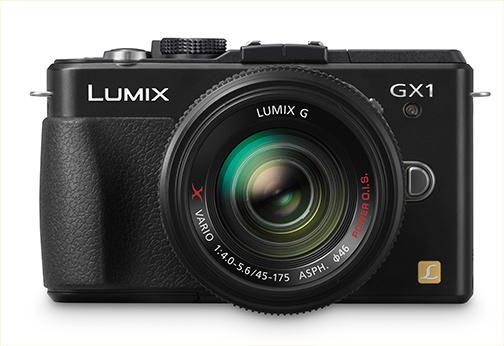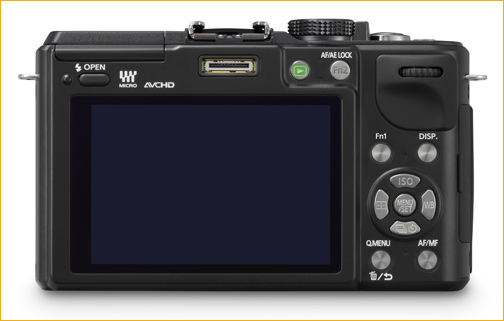
Before I begin my report on the new Panasonic GX1, please allow me a brief digression. We now have the Canon 1D X , Samsung N X 200, Fujifilm X -10, Ricoh G X R, Casio E X 15, Olympus X Z1, Sigma DP2 X , Sony H X 9V – and that’s with just one model from each company, and only since January. Now the Panasonic G X 1. And of course Panasonic’s X series lenses.
May I therefore humbly suggest to the camera industry that there are 25 other letters in the alphabet which aren’t getting much love these days. A little originality please.
A GF1 Successor?
In addition to the “X” issue, there’s a small matter of “F”s and “H”s. The Panasonic product line currently consists of five models; The GF2, GF3, G3, GH2 and now the GX1. As I understand it the GF line is Panasonic’s entry level, the G line their mid-range and the GH models their top of the line.
While the GF line started with the GF1, which had a mode dial and other external controls, with the GF2 and GF3 it morphed into a more consumer consumer oriented, smaller, and more svelte touch-screen camera. Now with the GX1 Panasonic has introduced a body which seems to be the spiritual successor to the highly regarded GF1 of yore. Simply stated, the new GX1 has Panasonic’s latest 16 Megapixel sensor from the G3, and has put it in a body that eschews the current GF line’s petite bar-of-soap styling. It’s sort of a GF4 in X clothing.
Size Comparison by Camerasize.com
So what we have is a hybrid. The original GF1’s styling and control functionality, a latest-generation sensor from the G3, and a new optional electronic viewfinder rather than the G3’s built-in EVF. The following then is a first-look at the new GX1, the two new X lenses, and the new EVF.
Image Quality
Let’s get this out of the way so that the pixel peepers can get on with their day. This report will not have any discussion of the GX1’s image quality. The reason for this is that the camera which I had for testing for a week was pre-production, using Firmware V0.1. Panasonic has requested that IQ not be discussed by reviewers until the camera is finalized, which is perfectly reasonable.
But since the sensor is essentially the same as the one in the G3, we can likely expect similar IQ performance, if not a bit better. Here is a quote frommy G3 reviewfrom June, 2011.
“Overall image quality was very good indeed. The jump from 12MP to 16MP has not detracted from IQ in any visible way. At ISO 160 and 200 the camera is as clean as one could wish. No, not as clean as a Leica M9, for example, but totally acceptable for just about any use, and prints up to about 13X19”.
ISO 400 and 800 start to show noise, but no worse that similarly priced cameras from Nikon, Canon, Pentax, etc. A bit of luminance smoothing in Lightroom and the images are certainly usable for most any purpose. Beginning at ISO 1600 noise begins to be problematic, and though it can be reduced, detail resolution starts to suffer.”
Breakfast. Toronto. November, 2011
Panasonic GX1 with 14-42mm X @ ISO 160
The Specs
You can readin detailabout every feature and function of the GX1 on the Panasonic web sitehere. But, in quick summary, this camera’s key points are…
– 16 Megapixel sensor (essentially the same as in the G3)
– touch screen with touch focus and touch shutter (can be disabled)
– ISO 160-12,800
– 1920 X 1080 60i HD video (30 fps)
– 3″ 360k dot LCD
– on-screen level gauge, both horizontal and vertical
– 4.2 FPS shooting
– SDXC (UHS-1) card compatibility
– built-in pop-up flash (GN=7.6 @ ISO 160) + hot shoe
– available 1.4M dot electronic viewfinder
These specs aren’t going to set the world on fire, but on the other hand they really represent a very attractive package, and make the GX1 a worthty successor to the highly regarded GF1.
Cosmetics

The GX1 isn’t as “pretty” camera. It’s far too hard-edged for that. But there is something about its utilitarian straightforwardness that I find very appealing. There’s a even a bit of retroness about its styling.
The camera is available in two finishes, silver and black. Depending on which country you’re in you may have available just one, the other, or both. The one I tested was silver; a very attractive pewterish colour. The only problem with it is that the lettering for button functions is white, making them almost invisible against the silver. Pretty, but not too productive. So unless the silver finish really turns your crank I’d go with the black, strictly from a functionality perspective.
Handling

Black Finish Rear Panel
There is a decent sized rubberized grip on the right front, and a thumb rest in the rear upper right corner. The only problem is that if you hold the camera that way, and with your index finger on the shutter release, the camera ends up being supported by your finger tips. Now, just to be clear, the GX1 is no worse in this regard than any other small camera. The human hand has certain ergonomic needs though, and frankly, on this camera the ideal place for the thumb rest would be where the Playback button is located. But then the camera would have to be larger, or the rear LCD smaller. Just saying.
Otherwise the camera’s surface real estate is well used. The photo above shows the button layout. The top panel has a mode dial, large shutter release button, IA button and video button. The mode dial is commendably stiff to set; unlikely not to be moved off position by handling or when coming in and out of a bag or pocket.
The shutter button is large enough that it can be easily found by touch, even with gloves on. The IA button is Panasonic’s (“Just press the shutter button dummy, and we’ll do the rest”). This turns out to be really handy, especially if you’ve set the camera to some specific combination of settings for a certain type of shot, and then a grab shot opportunity arises. Just press IA. The camera goes into its automatic mode overriding whatever settings you may have made. Take the opportunity shot. Now, press IA again and you’re back to your set of specific camera settings. And, just to be sure that you’re aware of what the camera is doing, there is a glowing blue light around the IA button which lights up when its engaged. Very cool. I also liked the new AF/MF button on the right rear. It’s very conveniently located.
The video button activates video recording in a fully automatic mode, regardless of the camera’s other settings. The only adjustments that can be made are exposure compensation and white balance. This protects the GH2’s dominance as Panasonic’s top video camera, indeed as one of the industry’s best video capable stills cameras, offering large sensor / deep DOF style shooting capability.
There is a manually actuated pop-up flash and also a hot-shoe. A new-style socket is located below the hot shoe, designed to take the new LVF2 electronic viewfinder. The LVF2 can not be used on previous Panasonic models.
Overall I give the GX1 high marks for ergonomics and handling in the context of a small camera.
The User Interface
Panasonic really gets user interface. They don’t always get ittotallyright, but more often than not there are several ways for the serious photographer to quickly access desired control settings. In other words, the GX1 has a high degree of customizability.
This starts with the top Mode dial, which has two Custom settings. These can be just about any combination of settings and adjustments that the camera is capable of. There are also two Custom Function buttons on the rear panel (one is also optionally AF/AE lock) which can be customized by the user.
The Qmenu button on the rear panel brings up a series of menus which provide rapid access to major settings, and their on-screen order can also be customized by the user. There’s even a new pop-out menu on the touch screen which provides access to several features, including the new on-screen Level Gauge and a live histogram, which can be user positioned anywhere on the screen.
Whew. There’s more, but I’m tired of typing. Enough to be said that this is among the most customizable small cameras on the market. If you can’t set the GX1 up to do exactly what you want, in the manner in which you want it, then the fault likely lies with you, not the camera.
No Peaking
No, notthatkind of peaking. “Focus Peaking”. Like all Micro Four Thirds cameras, the GX1 can use literally thousands of third party manual focus lenses, and for the quality conscious, especially Leica M lenses. During the past year or so both Sony and Ricoh have added peaking to their cameras. This makes focusing with MF lenses so much more accurate and quick. It would be really welcome if Panasonic would add this capability to future MFT models.
Protest Toronto. November, 2011
Panasonic GX1 with 45-175mm X @ ISO 400
LVF2 – Electronic Viewfinder
The new finder is very nice indeed. It has 1.4 million dots, is tiltable, with a locking position, and has diopter adjustment. The eye piece is rubberized to prevent scratching ones glasses. Coverage is 100%.
My concern though, from an operational point of view, is that neither the body nor the EVF have eye detect. This means that one has to constantly press the button just below the eye piece on the EVF to switch between it and the LCD.This gets very lame, very quickly. Shooting with the EVF is constantly interrupted by the need to press the switch to view function settings, menus or image review. (Yes, these can be seen in the EVF, but no one can work effectively that way).
Sony’s accessory EVF for the NEX-5n has built-in Eye Detect, as does the GH2, so how hard can it be?
I really welcome Panasonic though in producing a high quality accessory EVF for the new GX1, because their previous EVF was not as high resolution as one could have wished. (I’m being polite).
Two X Lenses
Under the rubricLumix G X VarioPanasonic has introduced two new lenses, a 45-170mm f/4-5.6 X zoom and a 14-42mm f/3.5-5.6 X zoom. The short zoom has just started shipping in the US, and sells for $399. The 14-42mm X is astonishingly small; half the size of the previous (and still available) 14-42mm. Parenthetically the older lens lens has a plastic mount while the new X lens has a metal mount.
The 45-170mm X lens is an alternative to the popular 45-200mm currently in the Panasonic line-up. It will cost $499 when is starts shipping. Both lenses feature a “nano surface coating” for reduced flare and enhanced light transmission.
Both of these lenses have power zooms, but that apparently is not what the X designates. Panasonic is using the X designation on some new lenses to indicate their premium nature. In future they could well use X on lenses that do not feature power zoom.
But back to these two lenses themselves. The 14-42mm X stand-out feature is that it is power-collapsible. Turn the camera on and the lens extends, turn it off and the lens retracts into itself, just like in most digicams. With the camera off the lens hardly is larger than a so-called pancake lens, and mounted on a GX1 body with lens attached can fit comfortably in a coat pocket.
Zooming is via a toggle switch on the left side of the lens barrel, as is manual focus via a separate switch. There are no manual focusing or zoom rings whatsoever. Neither are there any focal length or focus distance marks on the lens. When mounted on the GX1 there is a zoom range bar visible on the LCD or in the viewfinder.
Power zooming is also one of thereason d’etrefor these lenses. Large sensor DSLR style video in the hands of pro film makers doesn’t need zooming. Lenses are rarely zoomed while shooting, and in fact primes are preferred for optimum image quality. Zooms, when they’re used, are simply convenient multi-focal length lenses.
But amateurs don’t usually have or use sliders and dollies, (Check out of Guide to Cinematography for Photographers to learn more about this and other video shooting techniques), so for this, having a smooth silent zoom is important. The new lenses are designed so that a strong pressure on the zoom toggle zooms quickly, while softer pressure zooms more slowly.
Subjectively, while I really appreciate the small size of the 14-42mm X lens, I can’t say that I’m a fan of the lack of manual zoom control. Here’s the reason why. When you push the lever to zoom the lens to its widest or longest focal length, unless you are looking at the screen or through the viewfinder you have no way of knowing when it has reached its end stop. The resistance on the toggle doesn’t change. I frequently will zoom a lens to one or other of the stops on its range before lifting the camera to my eye to shoot. Discrete street photography demands that you don’t stand there with the camera to your eye waiting for the lens to reach its widest or longest extent. With this style of zoom control there’s no way to know when this has happened. You just have to wait until you think that’s its done.
Smash the State. Toronto. November, 2011
Panasonic GX1 with 45-175mm X @ ISO 500
Power focusing, in my book, is the pits. The lens is always under or overshooting. Just not my cup of tea. I do understand though why there is neither a manual zoom nor focus ring. Because the lens is collapsible there simply isn’t room. Each potential purchaser will have to decide if the trade-off for small size when the lens is collapsed is worth making.
The 45-170mm X has a power zoom toggle lever, but thankfully no power focus, because it isn’t a collapsible lens. The lens is very light, and like the 14-42mm X is essentially silent when zooming and focusing. This is vital when shooting video so that motor drive sound isn’t picked up.
While the 14-42mm X does vary its zoom speed, depending on the amount of pressure on the toggle lever, the zoom range is so short that it takes a very practiced touch to be able to get a slow zoom. On the 45-170mm X, on the other hand, I found the zoom speed much easier to control.
When using power zoom the maximum speed is limited, apparently so that the camera can keep up with it’s autofocus. One can zoom the lens manually much faster than the power mode is capable of.
GX1 with 45-170mm X zoom. Hand-held, showing power zooming capability.
Processed in Final Cut X. No Grading.
Focusing is either auto, or can be done manually by turning a ring. This is fly-by-wire, not a direct mechanical control. But at least its possible to adjust focus manually with some precision, unlike the over and undershooting which the 14-42mm X is prone to under power. When manually focusing, turning the focus ring on the lens puts the on-screen image into a magnified mode.
I really appreciate that the 45-170mm X lens can be zoomed manually by turning the zoom ring. Again, this is fly-by-wire, but works well and can be done quickly. But, there are no focal length marks on the lens, or focus distance, so it’s all done a bit blind when one isn’t actually looking at the image on-screen.
As I mentioned earlier, power zooming has no end stops. The resistance of the toggle doesn’t change at the end of the range, and the same applies to when zooming or focusing manually with the lens’ rings. Because both controls are fly-by-wire, they just continue turning after their end stops. This is the price that one pays for this technology. Some won’t mind. Some will.
Panasonic has announced firmware updates for both of these lenses.
14-42mm X lens update: http://panasonic.jp/support/global/cs/dsc/download/fts/dl/ps14042.html
45-175mm X lens update: http://panasonic.jp/support/global/cs/dsc/download/fts/dl/ps45175.html
According to Panasonic this upgrade will improve both autofocus and touch zooming performance.
First Impressions – For Now
Without being able to test or discuss image quality there isn’t that much more than can be said about the GX1 or the two new X lenses at this time. Cameras are about handling, features, specs, and most importantly – image quality. If it fails in terms of handling, features or specs, but is a winner in terms of IQ, then all is not lost. But if IQ is a fail, then the others don’t mean all that much.
So, at this point what I can say about the upcoming (December, 2011) GX1 is that when it comes to just about everything that I can test, the camera looks like a winner for Panasonic. If image quality turns out to be comparable or even slightly better than the G3 from this past summer, and there’s no reason to doubt that it will not, then there are bound to be a lot of GX1 cameras and X lenses in some folks Christmas stockings this season.
November, 2011
You May Also Enjoy...
Street-Video
Street Photography From Issue #4 Click on the image below to play a briefQuicktimevideo clip from Issue #4 of theVideo Journal. Remember, theVideo Journalis
The Last Ocean – Book Review
The Last Ocean Antarctica’s Ross Sea Project – Saving The Most Pristine Ecosystem On Earth By John Weller Rizzoli www.rizzoliusa.com ISBN 978-0-8478-4123-3 $50.00 Author





